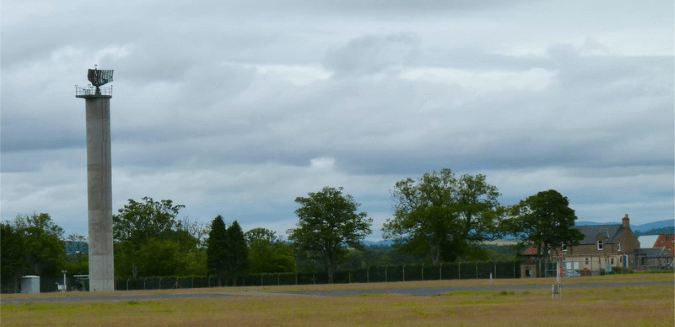Overview
Another proposed wind farm in the UK has been hit with a planning setback due to radar issues. The wind turbine radar issue has been a significant problem for many wind developers in the UK for many years now. Many proposed wind developments do not get planning permission because of radar objections. Those that do can still be halted until a suitable mitigation is agreed with the relevant radar stakeholder. The Govals Wind farm is a consented development in Scotland, another development hit by a radar set back, and now in need of a viable and agreeable mitigation solution.
 Figure 1: Radar conditions can be an option for moving forward
Figure 1: Radar conditions can be an option for moving forward
Govals Wind Farm
The Govals Wind Farm is a six-turbine project, with each wind turbine having a hub height of 60m above ground level (agl), a rotor diameter of 54m and an overall maximum tip height of 87m agl (as per the planning permission). Each wind turbine will have a generating capacity of up to 800kW, giving the wind farm an overall potential generation capacity of 4.8MW[1]. The wind farm was initially refused, but a subsequent appeal resulted in planning permission in December 2013[2].
MOD radar objection and Govals wind farm
The developer has until December of this year to discharge the planning condition by agreeing a suitable mitigation solution for the impact upon the Watchman Primary Surveillance Radar (PSR) at RAF Leuchars and the associated air traffic operations reliant on the PSR. The developer had 3 years to commence work on the wind farm otherwise the planning permission would lapse. If the condition is not discharged within this time, a new application would need to be submitted to regain planning permission.
 Figure 2: Radar at RAF Leuchars
Figure 2: Radar at RAF Leuchars
The Radar Planning Condition
In February of 2016, the developer submitted a planning application to revise condition 5 of the planning condition relating to the MOD radar issue that was originally issued. The first sentence of the original condition and then the newly proposed condition are presented below[3].
‘No development shall commence unless and until a Radar Mitigation Scheme has been submitted to and approved in writing by the planning authority to address the impact of the wind farm upon air safety…’
To
‘No construction of a wind turbine shall commence until the Radar Mitigation Scheme has been submitted to and approved in writing by the planning authority to address the impact of the wind farm upon air safety…’
The proposed change to the condition would mean that work on the wind farm could commence. However, in March 2016, the planning application was refused. The extract presented below shows the reasons for refusal[4].
‘1 The amendment sought could result in the development being implemented but, through possible failure to achieve an agreeable solution for the required Radar Mitigation Scheme, the development fail to realise the environmental and economic benefits set out in the submitted Environmental Statement (ES). Through its commencement this development could potentially lead to cumulative capacity being unavailable for other renewable developments to fulfil this contribution within Angus. For these reasons the proposed amendment could undermine Angus Council’s ability to contribute towards Scottish Government renewable energy targets and objectives to deliver a low carbon economy. This situation could be avoided through the retention of the existing Condition 5 of the extant permission. For these reasons to the proposal is contrary to the objectives of Scottish Planning Policy and Policy 6 of TAYplan.
2 The amendment sought could result in the development being implemented but, through possible failure to achieve an agreeable solution for the required Radar Mitigation Scheme, could result in adverse landscape and visual impacts and unacceptable impacts on the amenity enjoyed in the area by residents through intensified traffic, noise and local disruption within a more confined period of time that that which would be experienced through the extant permission. This situation could be avoided through the retention of the existing Condition 5 of the extant permission. For these reasons the proposal is contrary to the objectives development plan policies Policy ER5, Policy ER34 and Policy ER35 of the Angus Local Plan Review (ALPR).’
The aim was to commence work on the wind farm that would not impact upon the PSR at RAF Leuchars whilst continuing to explore viable and agreeable mitigation options. If no solution could be agreed, then the site would be returned to its original condition. Based on this refusal however, no work on the wind farm could commence and a mitigation solution would need to be agreed with the MOD as per the original condition.
Conclusions
This is another example where a predicted radar impact may halt an otherwise acceptable wind farm. For developers with a radar objection, it is worthwhile examining the likelihood of a viable mitigation solution being agreed within the allowable time of the planning permission. Alternatively, it may be wise to accurately assess the wording of the planning conditions so that suitable revisions can be agreed before the initial consent is given. The wider point is that developers should not agree conditions that cannot be discharged simply in order to gain planning permission.
For the Govals wind farm, unless a solution can be agreed with the MOD within the next two months, the proposed wind farm will not go ahead under the current planning permission. The planning application can be reviewed by clicking the link here and searching under keywords ‘Govals’.
References
[1] Angus Council Planning Permission Refusal, 31 March 2016. Reference 16/0005/EIAL. Last accessed 03/11/16.
[2] Directorate for Planning and Environmental Appeals Appeal Decision Notice. Planning appeal reference: PPA-120-2027. Date of appeal decision: 6 December 2013. Last accessed 03/11/16.
[3] Angus Council Report of Handling, 31 March 2016. Reference 16/00055/EIAL. Last accessed 03/11/16.
[4] Angus Council Planning Permission Refusal, 31 March 2016. Reference 16/0005/EIAL. Last accessed 03/11/16.
Image accreditation: “Radar tower” by James Allan via geograph / CC BY-SA 2.0 / Image cropped and resized from original.
